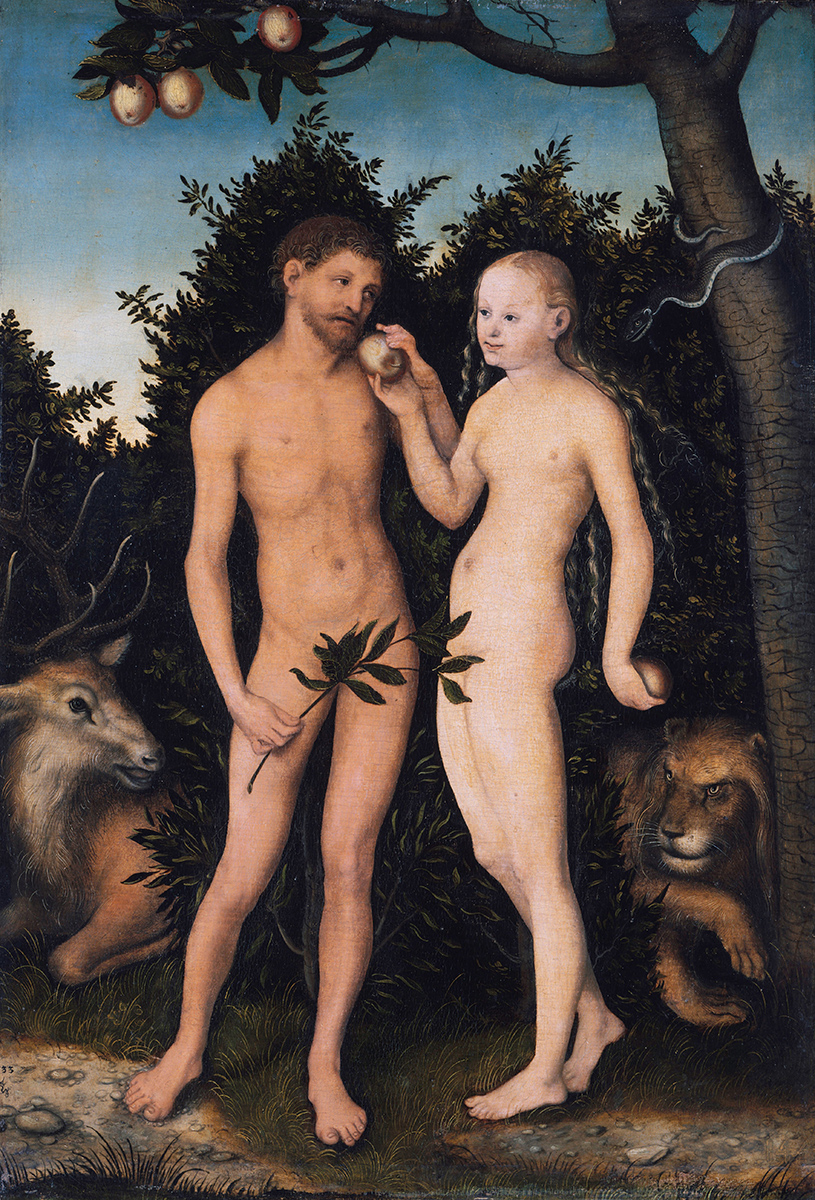It is said that the forbidden fruit is always the sweetest, but is it possible that this human eagerness to test the limits and go beyond what they are allowed is only a matter of curiosity, of challenging the rules? Is going further a sign of evolution or is it going too far? And why do we have this fascination with crossing the line? Maybe Adam’s apple got stuck and thus we cannot rest until we take it out of our system.
It is said that the forbidden fruit is always the sweetest, but is it possible that this human eagerness to test the limits and go beyond what they are allowed is only a matter of curiosity, of challenging the rules? Is going further a sign of evolution or is it going too far? And why do we have this fascination with crossing the line? Maybe Adam’s apple got stuck and thus we cannot rest until we take it out of our system.

The book of Genesis, in the Bible, notes that the first conversation there is a record of between God and Adam is about boundaries. God, who created Man first and then the Woman, Eve, said to the world’s first Man that everything on the Garden of Eden was within his reach, except the fruit of the Tree of Knowledge of Good and Evil and that, if we broke the rule, he would die. The perspective of an infinite roll of options, with one single exception, seemed not to be enough to satisfy the couple, who ate the forbidden fruit and got banned from Paradise. It was then that the expression, though its marginal drive was already present before, was born: the propensity to break barriers arrives when we are still kids (and gets more established during adolescence), constantly fascinated by what is new and unknown and thus, moved by innate curiosity, at the same time as there is the temptation to challenge parental authority. Not knowing and wanting to find out are both incentives that draw us, from an early age, into what is forbidden, whether for its novelty, the feeling it provokes, that adrenaline rush that makes us feel alive. The fact that at that time there is not yet a clear notion of the consequences and dangers also makes us bolder and more fearless. Adult life and its routine and responsibilities, as well as the notion of danger and its consequences that grow more solid as we grow up, can provoke some caution and consequent upkeeping of a certain distance from what could harm us. But memory and the temptation to dwell on dangerous grounds are still there, more or less intense, in certain individuals. The physiological mechanisms that manifest in the face of danger generate adrenaline that translates into this feeling which is, at the same time, pleasant and addicting: “Many people feel a particularly intense desire to venture beyond the safety limits in the search for pleasing, new or remarkable experiences, that make them feel particularly alive”, the clinical psychologist Filipa Jardim da Silva explains to Vogue. “It’s what we call ‘high sensation seeking’, where the search for more intense sensations that overcome the perception of physical, social, legal or financial risks. Frequently, these people perceive fear as a positive emotion and draw from those challenges their own self-confidence and value. For others, ‘low sensation seeking’, this type of challenge and danger doesn’t unleash the same level of enthusiasm or satisfaction, therefore are not seen as that much of an appealing choice.”
According to the specialist, “this phenomenon of searching for sensations is strongly connected to the limbic system of our brains, the part that is responsible for emotion, basic impulses and instinctive behavior, also known as ‘emotional brain’. It is in this system that we can find structures such as: the hypothalamus, which organizes the most important behaviors linked to the survival of the species (fighting, food, escape and reproduction), the hippocampus, one of the most ancestral areas of the human brain, and therefore, decisive in the regulation of the basic processes of our survival, and the amygdala, whose main function is to integrate emotions with the response patterns at a physiological and behavioral level. Thus, the limbic system is associated with the regulation of emotion, response to stress and long-term memory. Every time we receive a reward or create the expectation of receiving one, the limbic system releases dopamine, one of the neurotransmitters that create a feeling of happiness, and the insula, a structure that works alongside the pre-frontal cortex and the amygdala, is also activated. Essentially, people who search more for intense sensations have a higher neurochemical response to pleasure, enthusiasm or reward, which leads them to look for new challenges and experiences, ignoring or undervaluing some of the dangers involved”. Meaning, the idea, or its fulfillment, of searching for what isn’t allowed releases an adrenaline rush that feeds the attraction over what ‘is forbidden’, and some people are more moved by this sensation than others. Generally speaking, though, we all search for this neurochemical response that makes us “feel alive”, even if we can’t let go of safety – especially because human beings don’t deal well with boredom (and there are very few, if any, things that are less boring than the boldness that is breaking the rules). Our main task in life is to avoid idleness, according to the Philosophy Professor Brian O’Connor, from the University College of Dublin, in his book Idleness – A Philosophical Essay, who introduced the publication with the idea that we are incapable of living peacefully when we have nothing to do and that “we end up finding ways to occupy our time so that we don’t get bored”.
Does this mean that we’re capable of anything not to be bored? No. Especially because, according to what Filipa Jardim da Silva refers, each and every one of us searches for activities with more or less risk – not all ways of fighting boredom involve illegalities or challenging the status quo. However, what it means is that the forbidden fruit is always the sweetest, but only for some, and that traits such as personality and the final satisfaction of each experience dictate a greater or smaller propensity to what is forbidden. Characteristics such as age and gender may also influence this tendency, as the psychologist refers: “Several factors will tend to influence how much one challenge’s the rules, from those linked to brain chemistry, gender and personality traits, to education, peer groups and life experiences”, Filipa starts by contextualizing. “Gender is a factor to consider when it comes to taking risks. There are exceptions, of course, but in general, the male gender tends to take more risks than the feminine, or at least, different risks. Besides the social and cultural factors, there is also a biological foundation that partially drives the difference between genders. The expectation to adopt bolder and more fearless behaviors falls upon men, who tend to increase their resistance when they’re being watched, whether by their peers or the opposite gender. Thus, the male gender tends to assume more financial and recreational risks. But this doesn’t mean women don’t do so,” she states. “According to some studies, women tend to assume more social risks than men. It is therefore more likely for them to change careers or express opinions that are less consensual during work meetings. Those are different risks, as we can see. Besides gender, age is yet another variable to consider. Adolescents and young adults are more prone to take risks than any other age group, often adopting behaviors such as dangerous driving, excessive intake of alcohol, drug use or dangerous sexual behavior. Although research in this area has demonstrated that adolescents are just as good at evaluating risk as adults in a wide range of dangerous behaviors, it is also noticeable how in teenagers’ brains, the initial expansion of the grey matter indicates that the neuro paths are more abundant, which makes youngsters more open to experiences and more willing to try and learn new things than adults in general. This in itself might have a positive component. However, together with the fact that peer pressure activates certain brain signals which are connected to the reward center, adolescents tend to concentrate and value more their reference age group in situations of decision-making rather than the adults around them. Another variable that helps to understand the rising prevalence of risk behavior in young adults relates to greater emotional activation in situations of social exclusion. Teenagers have more difficulty in mobilizing the region of the brain (right ventrolateral prefrontal cortex) which helps them deal with negative feedback from others and regulating the level of suffering, given that during adolescence that cerebral region is still developing. Therefore, it is understandable that there is a temptation to perform risk behaviors as a way of avoiding being set apart or mocked by their peers” the specialist points out. It’s a question of self-control. Or lack thereof (whether on purpose or not). In fact, there are cognitive tests that not only point out our general level of intelligence, but also our risk intelligence, a way of naming or, in a way, of quantifying or qualifying one’s predisposition to take risks. “We might gain access to that information through cognitive or personality tests, which help us quantify the individual aptitude to take risks. What has been discovered by some studies and that I would like to point out is that there is a correlation between one’s aptitude to take risks and one’s level of intelligence. We’ve come to discover that young adults who more frequently take risks, and therefore are more active, always on the hunt for challenges and permanently learning, tend to have brains with bigger neuronal networks, which translates into more highly developed cognitive abilities such as decision-making, problem-solving and mental flexibility.”
In a way, taking risks and crossing boundaries is also what makes us challenge pre-established ideas and, ultimately, discover and contribute to evolution. After all, we’re also moved by the notion that there is something new, whether experience, overcoming or improvement-wise, on the other side of that line, beyond the prohibition, past the limitation. The truth is that Eve, and then Adam, didn’t randomly eat the forbidden fruit out of nowhere just because: they did it due to the promise of new horizons, deeper knowledge, moving closer to the divine. Because if they did, said the seductive serpent – this is, Satan in disguise – they would be like God. It was the perspective of something greater, of bettering themselves, of evolving, that led them to eat the fruit of the Tree of Knowledge (although, ultimately, they did it without taking into consideration collateral damages…). This is, nonetheless, a beautiful metaphor for this fascination for crossing the line – we don’t do it simply because we cannot; we do it in hopes or belief that doing it will bring us some kind of reward, trusting that what lays on the other side is something more evolved. “Various research has proved that, when it comes to searching for risk behavior and challenging of limitations, brain chemistry plays a significant role. In a way, factors such as the level of motivation and enthusiasm for the unknown, the perception of danger, the degree of self-control and the need one feels to challenge oneself, determine if one adopts more or less risk behaviors/ choices. Gender and each person’s individual definition of boldness also interfere.”, Filipa Jardim da Silva affirms. “As in the majority of aspects of our behavior, it is within our evolutionary past that we find the answers to how impulses and risk behaviors have evolved, despite inherent dangers, and why the prevalence of certain behaviors is different for each individual. That being said, there is something adaptable and advantageous in certain risky choices, in case they would have become extinct by now. Some studies have focused on radical sports athletes, for example, and found a set of common characteristics such as optimism, originality, high self-esteem, exacerbated levels of energy and a strong eagerness to control one’s faith. Many of these athletes don’t show signs of impulsiveness, quite the opposite actually; the highly demanding physical challenges they engage with call for a great ability to focus and remain concentrated despite the inherent adrenaline. Hence, it is more about personal overcoming and the inherent sensations to going beyond oneself, rather than the opinions of others.”
This concept of overcoming and of challenging risks, even if to do so there is no need to eat from any forbidden fruit, is not that foolish. After all, Eve was not that wrong and the serpent was not really lying (although the decision of risking a full Garden of satisfactory pleasures over a single forbidden thing is debatable): God says, in the book of Genesis, that Adam and Eve now had the knowledge of God, being just as aware as Him of the distinction between Good and Evil (“And the Lord God said, "The man has now become like one of us, knowing good and evil. He must not be allowed to reach out his hand and take also from the tree of life and eat and live forever." So, the Lord God banished him from the Garden of Eden to work the ground from which he had been taken.”, Genesis 3:22, from the Bible), and therefore could not enter Paradise any longer, given the risk of being His equals. In dead, the transgression provided them with additional wisdom, or novelty, but at what cost? Should we always challenge our limits, because that will inevitably result in evolution? Yes and no. “As in everything, the notion of equilibrium should be the rule”, the psychologist cautions. “If we think of adopting risks as a function of a spectrum, then the extremes would be unhealthy and not adaptable, whether it is avoiding all and every risk, or the polar opposite of permanently adopting risky behaviors that break the rules. If we consider risk as a situation that involves being exposed to danger, then we realize that many contexts in our daily routines inevitably comprise some exposition to potential danger and closing ourselves to that possibility is to stop living at all. Inherently to our development, there will be choices that implicate some given level of risk, it’s part of life. Since life is a dynamic thing and also brings along many new things, hence exposing ourselves to novelty might be challenging but also productive. It is also by not following the pre-established rules, but thinking more creatively and flexibly, that new solutions are found to old problems and so many inventions are born, as well as useful projects and services to society. To absolutely avoid risk is an illusion and will tend to reflect conformity, lack of self-confidence, difficulty in dealing with fear, a need for control and exacerbated predictability, and/ or even lack of goals that are set and motivating. To relax certain rules and a certain amount of risk is healthy for our brain, life and survival as a society. Permanent risk and complete disrespect for rules are generators of chaos”, she warns. Right. Because as a counterweight for the expression “the forbidden fruit is always the sweetest”, there’s also that other one that says, “curiosity killed the cat”. When it comes to misbehaving, the rule is knowing how to measure the consequences, the cost-benefit of the action, not only for those doing it but for others as well. Because many of the risks we take, don’t only involve ourselves, but others too. And that is why risks exist. If some are too tight and should be extended, there is room for discussion. But, in the end, to evolve also means knowing how to risk in a balanced way. Virtue always lies in the middle. So, next time you feel like eating an apple, think long and hard about the consequences. Sometimes it’s better to opt for an orange. Sometimes.
*Translated from the original on Vogue Portugal's The Forbidden Issue, published april 2021.
Most popular


Relacionados
.jpg)





